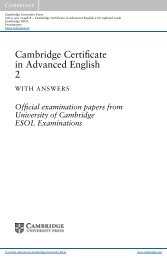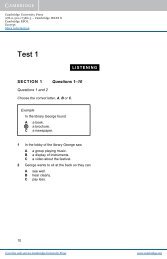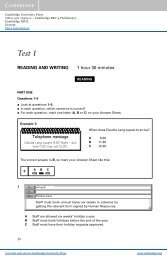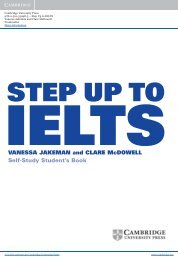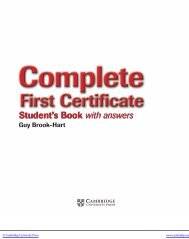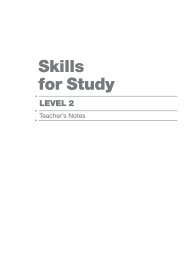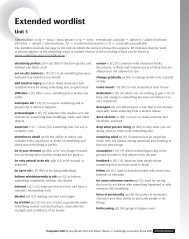<strong>Cambridge</strong> <strong>University</strong> <strong>Press</strong>978-0-521-73830-9 - Physics 2 for OCRGurinder Chadha and David SangExcerptMore information<strong>Chapter</strong> 1: MomentumModelling collisionsSpringy collisionsFigure 1.3a shows what happens when one snookerball collides head-on with a second, stationary ball.The result can seem surprising. The moving ball stopsdead. The ball initially at rest moves off with thesame velocity as that of the original ball. To achievethis, a snooker player must observe two conditions:The collision must be head-on. (If one ball strikesa glancing blow on the side of the other, they willboth move off at different angles.)The moving ball must not be given any spin. (Spinis an added complication which we will ignore inour present study, although it plays a vital part inthe game of snooker.)aFigure 1.2 If you play snooker often enough, youwill be able to predict how the balls will move on thetable. Alternatively, you can use the laws of physicsto predict their subsequent motion.b2a hockey stick strikes a ball a comet or an asteroid collides with a planet as itorbits the Sunthe atoms of the air collide constantly with eachother, and with the walls of their surroundingselectrons that form an electric current collide withthe vibrating ions that make up a metal wiretwo distant galaxies collide over millions of years.From these examples, we can see that collisions arehappening all around us, all the time. They happenon the microscopic scale of atoms and electrons, theyhappen in our everyday world, and they also happenon the cosmic scale of our universe.Figure 1.3 a One snooker ball hits another head-on.b You can do the same thing with two trolleys inthe laboratory.You can mimic the collision of the snooker ballsin the laboratory, using two identical trolleys, asshown in Figure 1.3b. The moving trolley has itsspring-load released, so that the collision is springy.compressed, and then it pushes out again to set thecomplete halt. The ‘motion’ of one trolley has beentransferred to the other.© <strong>Cambridge</strong> <strong>University</strong> <strong>Press</strong> www.cambridge.org
<strong>Cambridge</strong> <strong>University</strong> <strong>Press</strong>978-0-521-73830-9 - Physics 2 for OCRGurinder Chadha and David SangExcerptMore information<strong>Chapter</strong> 1: MomentumYou can see another interesting result if twomoving identical trolleys collide head-on. If thecollision is springy, both trolleys bounce backwards.If a fast-moving trolley collides with a slower one,the fast trolley bounces back at the speed of the slowone, and the slow one bounces back at the speed ofthe fast one. In this collision, it is as if the velocitiesof the trolleys have been swapped.Sticky collisionsFigure 1.4 shows another type of collision. In thiscase, the trolleys have adhesive pads so that they sticktogether when they collide. A sticky collision likethis is the opposite of a springy collision like the onesdescribed above.SAQ1 Here are two collisions to picture in your mind.Answer the question for each.a Ball A, moving towards the right, collideswith stationary ball B. Ball A bounces back;B moves off slowly to the right. Which has agreater mass, A or B?b Trolley A, moving towards the right, collideswith stationary trolley B. They stick together,and move off slower than halfA’s original speed. Which hasAnswerthe greater mass, A or B?From the examples discussed above, we can seethat two quantities are important in understandingcollisions:massm of the objectvelocityv of the object.These are combined to give a single quantity, calledthe linear momentum (or simply momentum) p ofas the product of the mass of the object and itsvelocity. Hence:momentum = mass velocityp = mvFigure 1.4 If a moving trolley sticks to a stationarytrolley, they both move off together.If a single moving trolley collides with a singlestationary one, they both move off together. Afterthe collision, the speed of the combined trolleys ishalf that of the original trolley. It is as if the ‘motion’of the original trolley has been shared between thetwo. If a single trolley collides with a double one(twice the mass), they move off with one-third of theoriginal velocity.From these examples of sticky collisions, you cansee that, when the mass of the trolley increases as aresult of a collision, its velocity decreases. Doublingthe mass halves the velocity, and so on.The unit of momentum is kg m s . There is nospecial name for this unit in the SI system.Momentum is a vector quantity because it is aproduct of a vector quantity (velocity) and a scalarquantity (mass). Momentum has both magnitudeand direction. Its direction is the same as thedirection of the object’s velocity.In the earlier examples, we described how the‘motion’ of one trolley appeared to be transferredto a second trolley, or shared with it. It is morecorrect to say that it is the trolley’s momentumthat is transferred or shared. (Strictly speaking, weshould refer to linear momentum, because there isanother quantity called angular momentum, which ispossessed by spinning objects.)3© <strong>Cambridge</strong> <strong>University</strong> <strong>Press</strong> www.cambridge.org



